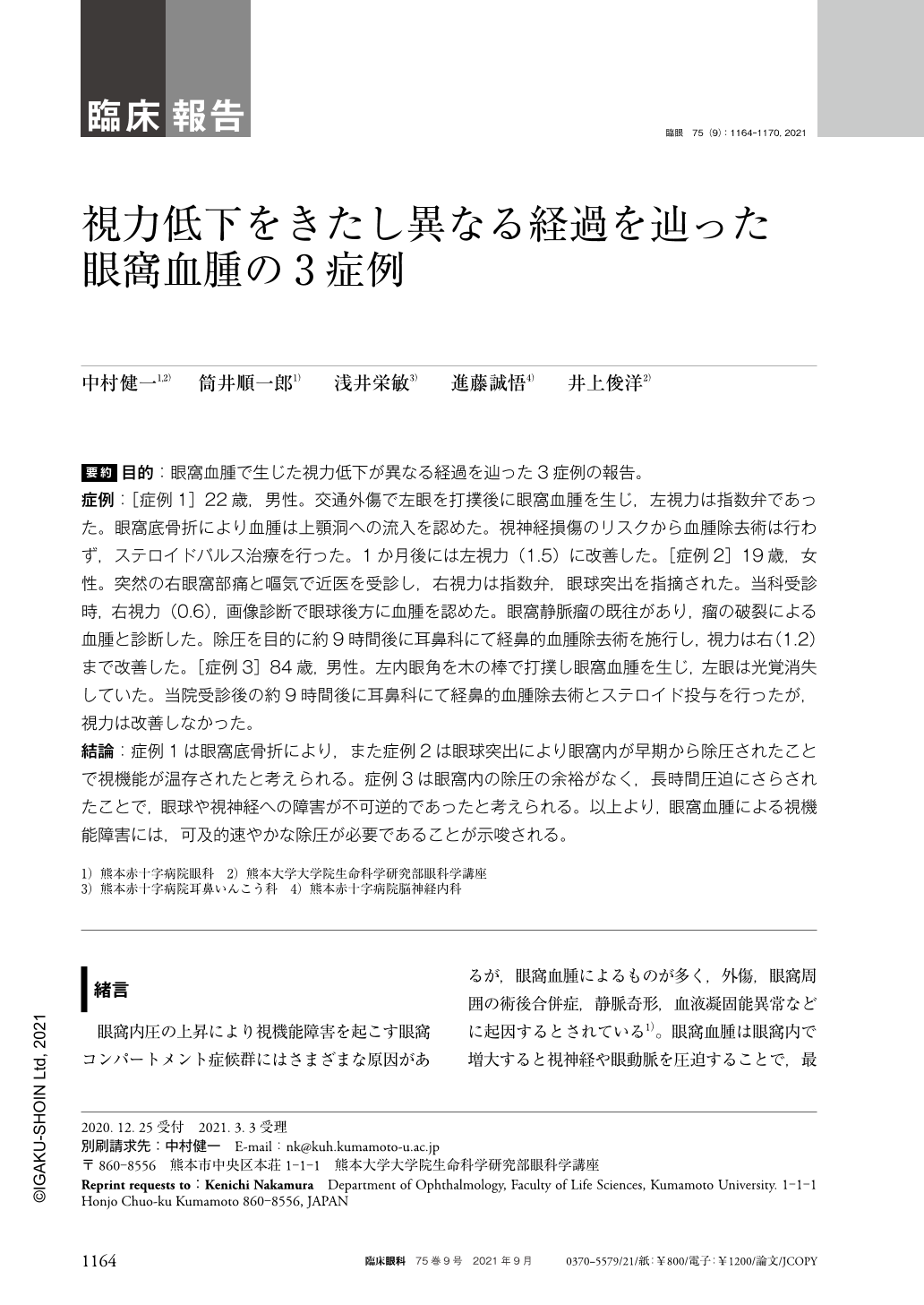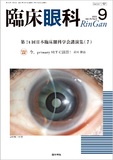Japanese
English
- 有料閲覧
- Abstract 文献概要
- 1ページ目 Look Inside
- 参考文献 Reference
要約 目的:眼窩血腫で生じた視力低下が異なる経過を辿った3症例の報告。
症例:[症例1]22歳,男性。交通外傷で左眼を打撲後に眼窩血腫を生じ,左視力は指数弁であった。眼窩底骨折により血腫は上顎洞への流入を認めた。視神経損傷のリスクから血腫除去術は行わず,ステロイドパルス治療を行った。1か月後には左視力(1.5)に改善した。[症例2]19歳,女性。突然の右眼窩部痛と嘔気で近医を受診し,右視力は指数弁,眼球突出を指摘された。当科受診時,右視力(0.6),画像診断で眼球後方に血腫を認めた。眼窩静脈瘤の既往があり,瘤の破裂による血腫と診断した。除圧を目的に約9時間後に耳鼻科にて経鼻的血腫除去術を施行し,視力は右(1.2)まで改善した。[症例3]84歳,男性。左内眼角を木の棒で打撲し眼窩血腫を生じ,左眼は光覚消失していた。当院受診後の約9時間後に耳鼻科にて経鼻的血腫除去術とステロイド投与を行ったが,視力は改善しなかった。
結論:症例1は眼窩底骨折により,また症例2は眼球突出により眼窩内が早期から除圧されたことで視機能が温存されたと考えられる。症例3は眼窩内の除圧の余裕がなく,長時間圧迫にさらされたことで,眼球や視神経への障害が不可逆的であったと考えられる。以上より,眼窩血腫による視機能障害には,可及的速やかな除圧が必要であることが示唆される。
Abstract Purpose:To report three cases of orbital hematoma showing different courses in visual loss.
Case:Case 1:After a traffic injury, a 22-year-old man had orbital hematoma in the left orbit. His visual acuity was counting fingers. Computed tomography(CT)showed fracture of the orbital floor and retrobulbar hemorrhage moving to the maxillary sinus. He was treated with steroid pulse therapy. His left visual acuity improved to 1.5 one month after the therapy. Case 2:A 19-year-old woman suddenly had right ophthalmalgia and nausea. Her right corrected visual acuity had been counting finger, and she had been exophthalmic when she presented to an ophthalmic clinic. When she was referred to us, her corrected visual acuity was 0.6, and CT showed orbital hematoma in the right orbit. As her orbital varix had been pointed out in childhood, we diagnosed her as having retrobulbar hemorrhage caused by rupture of the varix. Endoscopic removal of orbital hematoma was performed by an otorhinolaryngologist for decompression after approximately 9 hours of onset, and her corrected visual acuity improved to 1.2. Case 3:An 84-year-old man had been stabbed in the left medial canthus with a wooden stick. His visual acuity was no light reception. CT showed orbital hematoma in the left orbit and no fracture of the orbital bone. He received endoscopic removal of orbital hematoma by the otorhinolaryngologist and steroid therapy. However, his visual acuity did not improve.
Conclusion:Decompression with fracture of the orbital floor in the first case and exophthalmos in the second case occurred early. Therefore, we considered that their visual acuity improved. In the third case, because the time to decompression was long, we considered that the damage to the ophthalmus and optic nerve were irreversible. Decompression should be performed without delay if orbital hematoma causes symptoms of compression.

Copyright © 2021, Igaku-Shoin Ltd. All rights reserved.


